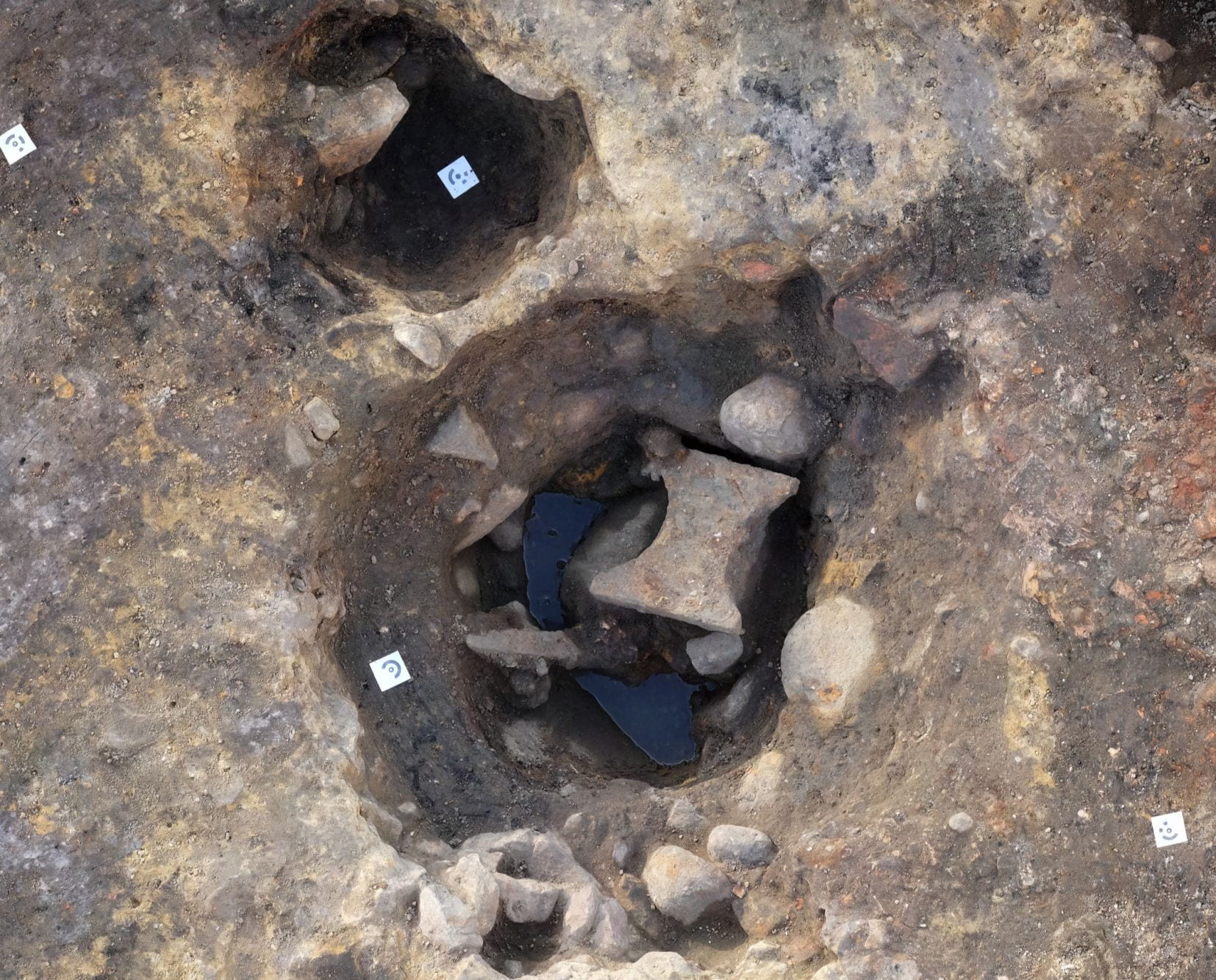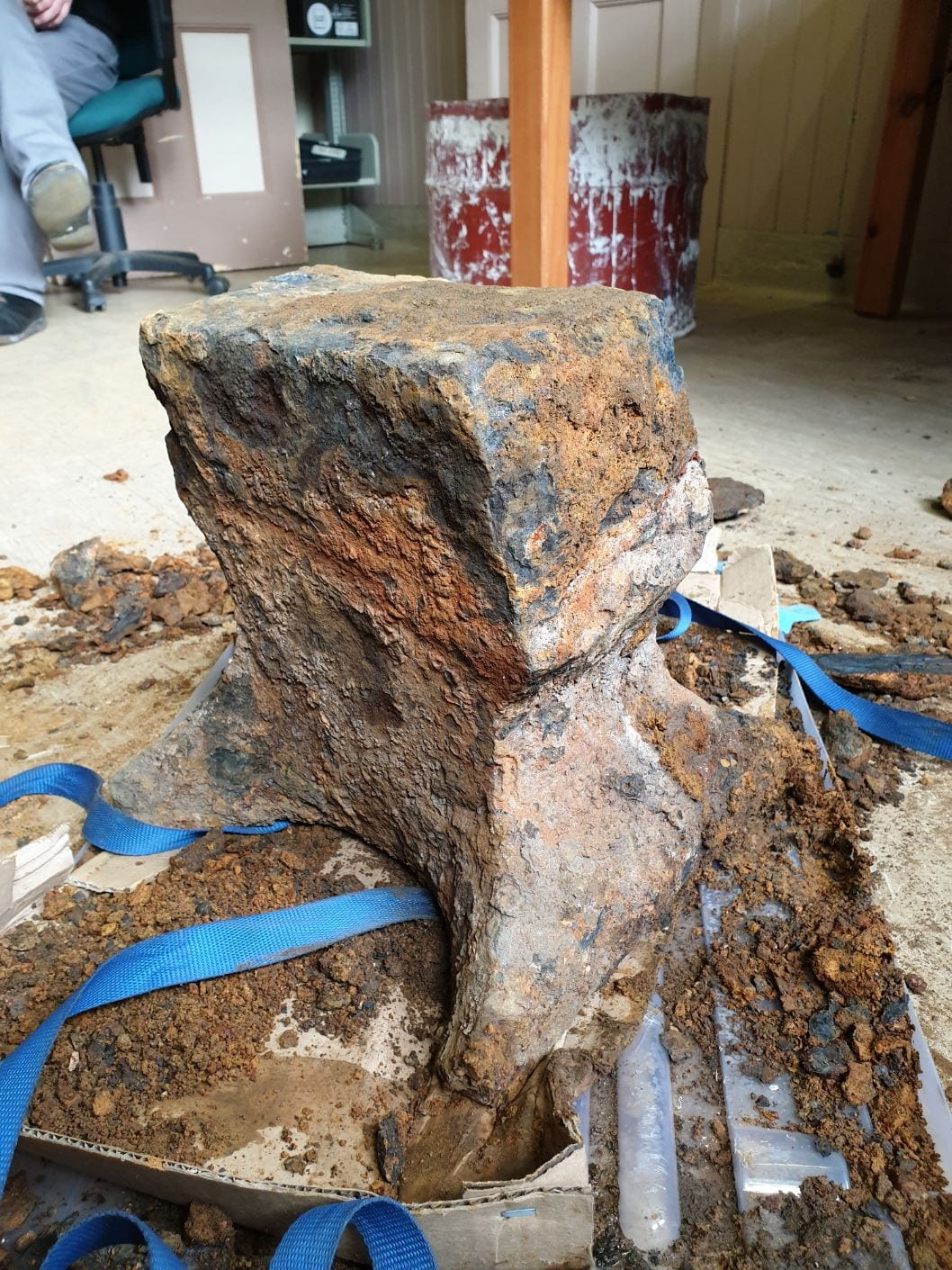So, as we kick off National Archaeology Week, we’d like to share with you one of the more interesting finds so far. As the title is a bit of a giveaway, I’ll cut straight to the chase. No teasing.
We found an anvil.
You don’t get more blacksmithery than that do you? Firstly, credit to the find has to go to our two beautiful assistants, Caitlin D’Gluyas and Prof Martin Gibbs, both from the University of New England. They worked on the site with us during April and both were tasked with the excavation of the pit in which the anvil was found. This pit was near the centre of the site, circular in shape and cut into the reclamation clay. As yet, we have not figured out its purpose – but think that it had something to do with an activity in the foundry. The top of the pit was filled with round dolerite boulders and a huge amount of ironworking waste (slag). The anvil was upside-down right at the bottom of the hole. Here’s a little video I did before we had hauled the thing out of there.
With the help of John and Matt, stalwarts of the Port Arthur crew, we got the horrifically heavy hunk of iron out of the hole with no damage to it or the hole.
The anvil was whisked away to the lab, where conservator Michelle Berry got stuck into the worst of the concretion stuck to its top.
At the end of this process (which took half a day of careful cleaning) we have something that now looks a bit more anvil-like. On advice from Michelle, the anvil is now sitting in its own special little bath to help it stablise, ensuring we don’t lose more metal to corrosion. It will then undergo a long process of conservation, further removing corrosion residues and exposing the original surface.
One thing you will immediately notice is that the anvil does not have a horn/horns. One side of the anvil is squared and smooth, the other a bit more jagged. We think that the horn has actually been broken off. Whether this was due to accident, or malicious intent, we will never know. However, what we can say is that this is highly likely to be an anvil from the convict period. The coincidence of it ending up in a convict blacksmiths’ shop is almost too great for it to be otherwise.
Yet, we don’t know if the event that led to it ending up in the hole occurred during the convict period. It looks like a ‘closing’ event, when the shop went out of use and the area was tidied. This is why we found so much metalworking waste in the pit. Was the anvil thrown away because it was broken? Was it broken after they decided to throw it away? How do you even break the horn off an anvil? It seems very wasteful to discard such a large amount of valuable metal. One possibility is that the anvil was deposited in the 1880s. The foundry and blacksmith remained open for a decade after 1877, the building being used by townsfolk, with tourists also wandering about. At the close of the 1880s the government cracked-down on the use of the structure, which was potentially when they threw the anvil away.
Whatever the case, this object has a pretty cool story to tell. As we conserve it, we hope to find some markings (government mark, maker’s mark, weight) stamped into the metal. If we do, you’ll be the first(ish) to know…
Happy Archaeology Week!







Thx for the reports. My great grandfather, Linus Miller was a convict there , early 1840’s. Wrote a memoir . Managed to make it home to NY state 1846.
As in THE Linus Miller! Goodness, that’s one interesting ancestor you have there. He left a pretty full account of his time in the convict system, which is a pretty useful text for getting insight into one convict’s view of imprisonment.
congratulations Rich!
Why, thank you father. Please tell the remainder of the family I expect similar comments.
these anvils were put together by forge welding the feet, horn, heel and top plate onto a block of iron. The heel and horn welds often failed. A lot of us collectors have examples of these. I have one in pretty good condition minus the horn and my theory is that the weak horn forge weld revealed itself early on after its purchase and it was shoved under the work bench and replaced. That’s just my theory though. Cool find!
And this is why blogs are useful! Thanks the for awesome reply. We had a feeling it was something like this – but a feeling is not evidence nor fact. I’ve had a chat to a few people that know about these things, who have also confirmed that the welds could go on the horn – particularly if you are ‘trying’ to break it (i.e. a disgruntled worker). We do know that they were making anvils at Port Arthur (is it a particularly complex process?) – so perhaps this is tantalising evidence of poor workmanship? The anvil is currently being conserved, so we are hoping once it has had the corrosion elements removed, we will see the telltale ‘P.A.’ and a broad arrow stamp. If not, we are hoping for another makers’ mark. Will update as evidence emerges. In the meantime, drop me an email (rtuffin@une.edu.au) if you have further info that might be of interest. I’m writing the report at the moment…